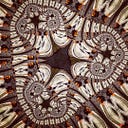The Future of Art and the Thin Line Between Creative AI and Obedient Algorithms
In 2016, I came across an article about Generative Adversarial Networks (GANs) and thought, what if we could use it to generate art? I had no GPU and was still getting familiar with cloud computing.
Due to GPU VRAM limitations, I had to limit my ambition of generating artworks to that of people, people that do not exist. The training dataset was 1001 pictures of people from all diversity, ages, and genders from my project 1001 faces.
The result was “Children of the Cloud”, thousands of AI-generated faces from all origins, ages, and genders, united into one artwork shown at the Grand Palais on Feb 13th, 2018.
Although GANs act with artificial neural networks like a black box when generating new faces or any content at large, much of the outcome can be predicted and manipulated with the algorithm’s hyperparameters.
It is therefore meaningless to make any assumption about an algorithm that has no awareness of what it is training on or producing. The AI in this case is a translator from one set of dimensions to another using filters and kernels. It is a sort of a hack of our cultural understanding without understanding it based on associations between millions of cultural references between massive amounts of data. The use of big data for making analogies that we would understand is hence based on shallow logical associations that lack “emotional intelligence”.
Even when the most powerful tools of AI are united to write, dub, edit and produce a short film animation autonomously, the outcome after several revisions and curations lacks depth.
Most journalists love to exaggerate the intelligence of artificial intelligence and how we are soon to be doomed by it. The interest of a journalist lies solely in selling articles based on fear and speculation. Not all journalists, of course!
When the camera came about, artists and especially realists, feared that photographers will replace them. However, the camera remained a tool that a photographer used to take pictures. When in the wrong hands, the camera produced mediocre pictures.
Analogously, AI is a tool like a camera with several more parameters than shutter-speed, aperture, subject, frame, and focal length, that an artist has to master or the AI will produce mediocre results.
I see art evolving with AI in a way that image manipulation added to photography without putting photographers out of business. I see AI becoming a tool that will transform or map a painting made by an artist to a painting realized by a collective consciousness, assuming it has been trained on massive amounts of paintings.
The AI is efficient enough to dance along the artist’s will yet not enough to be creative on its own and therefore the collaboration between artists and AI have created a new school of art.
